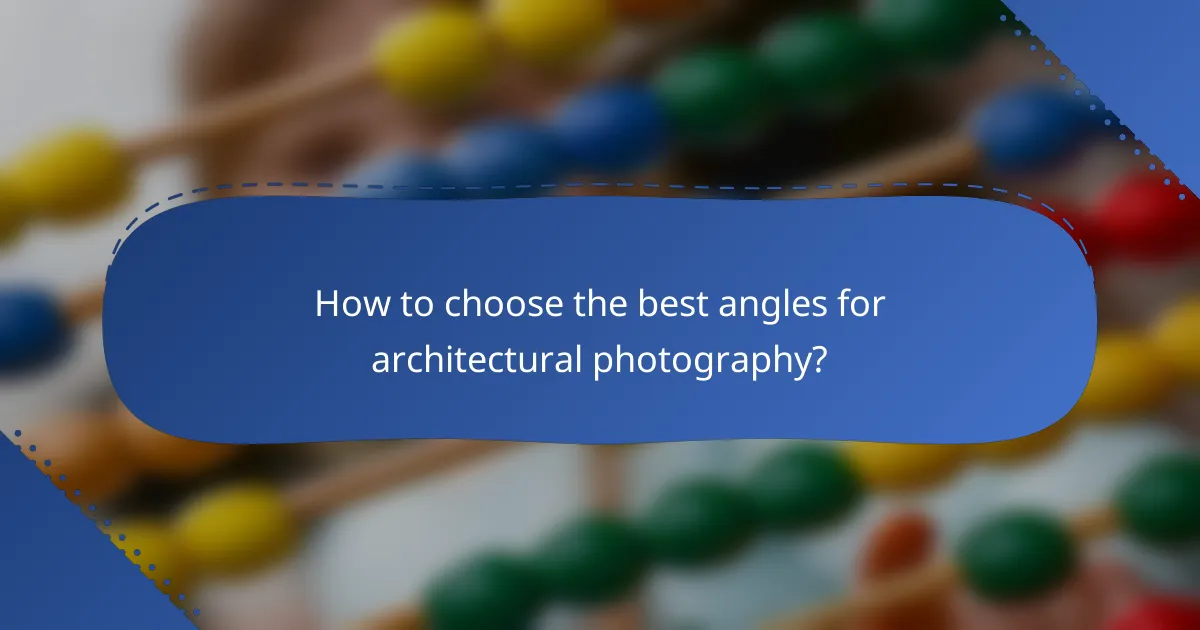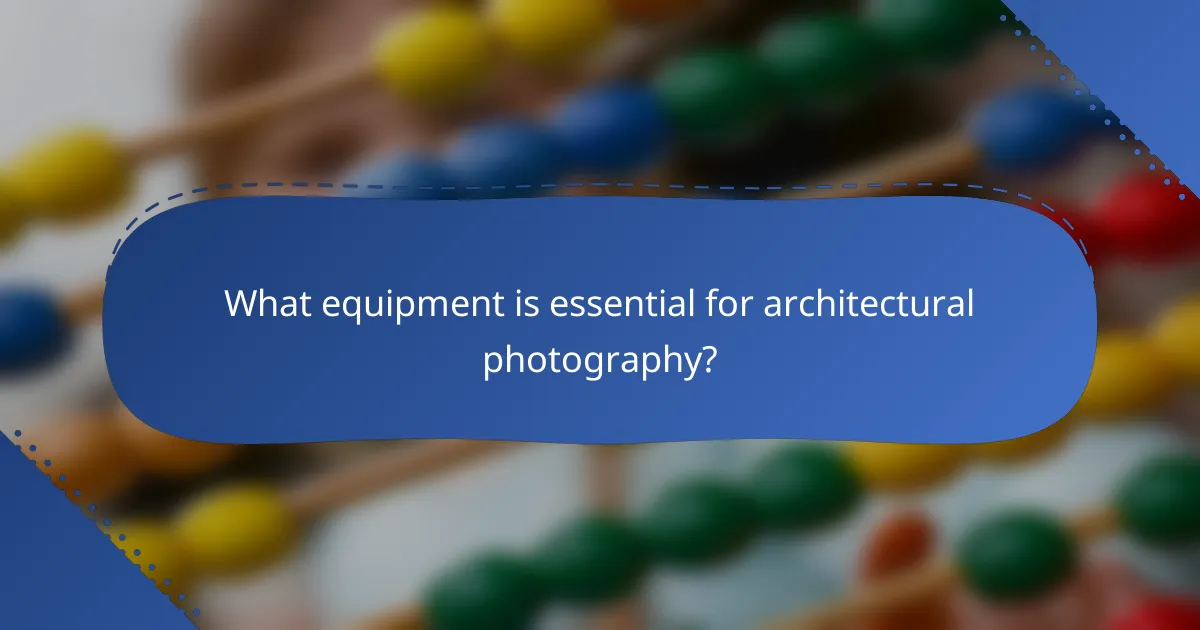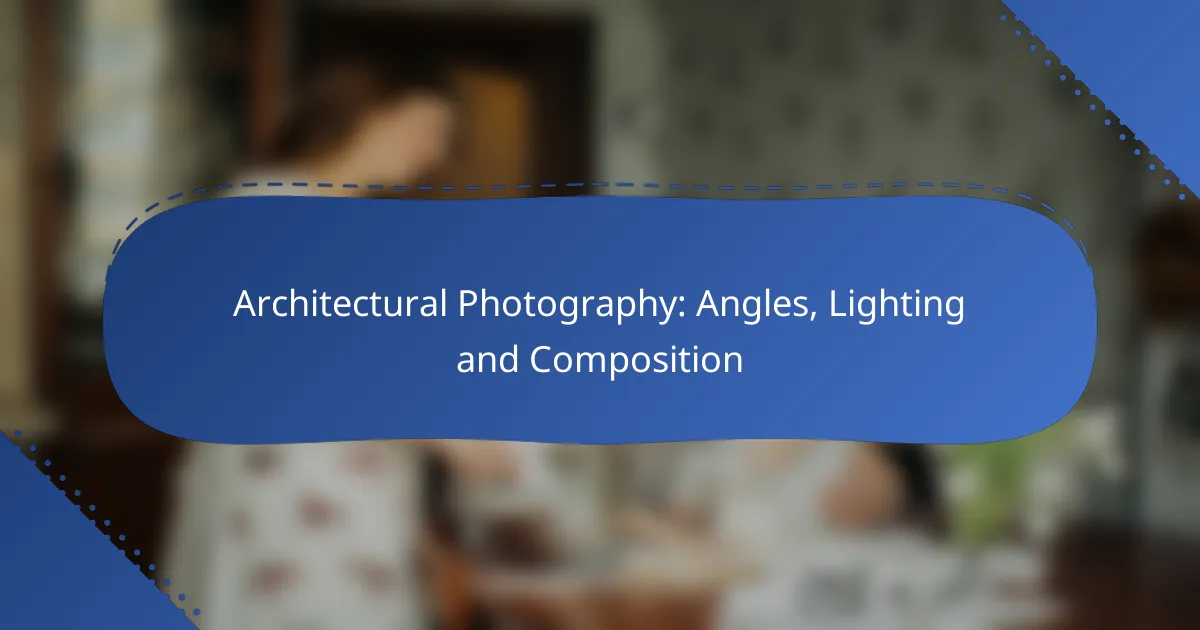Architectural photography is an art that requires a keen eye for angles, lighting, and composition to truly capture the essence of a structure. By understanding how different perspectives can highlight or obscure a building’s features, photographers can create images that evoke emotion and convey the design’s intent. Mastering lighting techniques and composition strategies further enhances the visual appeal, allowing for striking and memorable photographs.

How to choose the best angles for architectural photography?
Choosing the best angles for architectural photography involves understanding how different perspectives can enhance or diminish the subject’s features. Key considerations include the building’s design, surrounding environment, and the desired emotional impact of the image.
Wide-angle perspectives
Wide-angle perspectives are essential for capturing the entirety of large structures, especially in tight spaces. This approach allows you to include more of the surroundings, providing context and scale. When using a wide-angle lens, be mindful of distortion, particularly at the edges, which can alter the building’s proportions.
To effectively use wide-angle perspectives, position yourself at a distance where the entire structure fits within the frame. A focal length between 14mm and 24mm is commonly used for this type of shot, but be cautious of excessive distortion that can detract from the architectural details.
Low-angle shots
Low-angle shots can create a sense of grandeur and dominance, making buildings appear more imposing. This technique emphasizes vertical lines and can enhance the sky’s presence, adding drama to the composition. Positioning the camera lower than the subject often results in a more dynamic perspective.
When taking low-angle shots, consider the foreground elements that may enhance the image, such as trees or other structures. Aim for a focal length of around 24mm to 35mm to maintain clarity while capturing the building’s height and details effectively.
High-angle views
High-angle views provide a unique perspective that can reveal patterns and layouts not visible from ground level. This angle can help showcase the relationship between the building and its environment, making it particularly useful for urban settings. Aerial shots can be achieved with drones or from elevated positions.
For high-angle photography, consider using a focal length of 35mm to 50mm to balance the building’s details with its surroundings. Ensure that the lighting is favorable, as shadows can obscure important features when shooting from above.
Symmetrical framing
Symmetrical framing emphasizes balance and harmony in architectural photography. This technique works well with buildings that have a central axis, drawing the viewer’s eye to the focal point. Symmetry can evoke feelings of stability and order, making it a powerful compositional tool.
To achieve symmetrical framing, position yourself directly in front of the building’s centerline. Use a tripod to maintain alignment and ensure that vertical lines remain straight. This approach is particularly effective for iconic structures like cathedrals or government buildings.
Dynamic compositions
Dynamic compositions involve using angles and lines to create movement and interest within the photograph. This technique can include leading lines, diagonal elements, and unconventional viewpoints that engage the viewer. Dynamic images often convey a sense of energy and modernity.
To create dynamic compositions, experiment with different angles and perspectives. Incorporate elements like pathways or railings that lead the eye through the frame. A focal length of 24mm to 50mm can help capture these elements effectively while maintaining clarity and detail in the architecture.

What lighting techniques enhance architectural photography?
Effective lighting techniques are crucial for enhancing architectural photography, as they can dramatically alter the perception of a structure. Utilizing natural light, understanding the golden hour, incorporating artificial lighting, and mastering shadow play are key strategies to achieve striking images.
Natural light usage
Natural light is often the most flattering for architectural photography, as it highlights textures and colors without harshness. Photographers should consider the time of day and weather conditions, as overcast skies can soften shadows and create a more even light distribution. Aim to shoot during times when the sun is lower in the sky to maximize the quality of light.
Golden hour advantages
The golden hour, occurring shortly after sunrise and before sunset, provides warm, diffused light that enhances architectural features. During this time, shadows are longer, adding depth and dimension to buildings. Photographers should plan their shoots around this period to capture the most visually appealing images.
Artificial lighting options
Artificial lighting can be used to illuminate architectural subjects when natural light is insufficient. Options include LED lights, flash units, and continuous lighting setups. When using artificial light, consider the color temperature to ensure it complements the existing light and enhances the overall aesthetic of the photograph.
Shadow play techniques
Utilizing shadows effectively can add drama and interest to architectural photographs. Experiment with different angles and light sources to create dynamic shadow patterns that emphasize lines and shapes. Be mindful of the time of day, as the position of the sun will significantly affect shadow length and intensity.

How to effectively compose architectural photographs?
To effectively compose architectural photographs, focus on using techniques that enhance the structure’s visual appeal. Key elements include the rule of thirds, leading lines, framing elements, and balancing foreground and background to create a compelling image.
Rule of thirds application
The rule of thirds is a fundamental compositional technique that divides the frame into a grid of nine equal parts. Positioning key architectural features along these lines or at their intersections can create a more dynamic and engaging photograph. For example, placing a building’s entrance at a third of the way across the image can draw the viewer’s eye naturally.
When applying this rule, consider the horizon line as well. Placing it along the top or bottom third can emphasize either the sky or the building itself, depending on what you want to highlight.
Leading lines incorporation
Leading lines are visual pathways that guide the viewer’s eye toward the main subject of the photograph. In architectural photography, elements like roads, pathways, or the edges of buildings can serve as effective leading lines. These lines create depth and perspective, making the image more inviting.
When composing your shot, look for natural lines in the environment that lead toward the architecture. This could be a sidewalk leading to a building or the lines of a staircase. Experiment with angles to find the most effective way to incorporate these lines into your composition.
Framing elements
Framing elements involve using surrounding features to create a ‘frame’ around the architectural subject. This technique can add context and depth to your photograph. For instance, shooting through an archway or between trees can focus attention on the building while providing a sense of place.
When selecting framing elements, ensure they complement rather than distract from the main subject. Look for natural or architectural features that enhance the composition without overwhelming it.
Balancing foreground and background
Balancing foreground and background is crucial in architectural photography to create a harmonious composition. The foreground can add interest and context, while the background should support the main subject without competing for attention. Aim for a clear distinction between the two to guide the viewer’s focus.
Consider using objects in the foreground, such as plants or people, to add scale and depth. However, be cautious not to clutter the scene. A well-balanced image often has a clear focal point, with the background subtly enhancing the overall composition.

What equipment is essential for architectural photography?
Essential equipment for architectural photography includes a quality camera, appropriate lenses, a sturdy tripod, and filters to enhance image clarity. Each piece of equipment plays a vital role in capturing the intricate details and overall composition of architectural structures.
Camera recommendations
For architectural photography, a DSLR or mirrorless camera with a full-frame sensor is ideal, as it provides better image quality and dynamic range. Popular models include the Canon EOS R series and the Nikon Z series, which offer excellent performance in various lighting conditions.
Consider cameras that allow for manual settings, enabling control over exposure and focus. This flexibility is crucial for capturing the nuances of architectural designs, especially in challenging lighting situations.
Lens selection
Wide-angle lenses are essential for architectural photography, as they allow you to capture more of the structure in a single frame. Lenses with a focal length between 14mm and 24mm are commonly used to showcase large buildings and tight spaces.
Additionally, tilt-shift lenses can be beneficial for correcting perspective distortion, ensuring that vertical lines remain straight. This is particularly important when photographing tall buildings or intricate facades.
Tripod importance
A sturdy tripod is crucial for architectural photography, especially in low-light conditions or when using longer exposure times. It stabilizes the camera, preventing blurriness and allowing for sharper images.
Look for tripods that are adjustable and can support the weight of your camera and lens setup. A tripod with a ball head can offer flexibility in positioning your camera at various angles for creative compositions.
Filters for clarity
Using filters can significantly improve the quality of your architectural photographs. Polarizing filters help reduce glare and reflections, enhancing colors and contrast in your images.
Neutral density (ND) filters are also useful, allowing for longer exposures in bright conditions without overexposing the image. This can create stunning effects, such as smooth water or cloud movement around architectural elements.

What are common mistakes in architectural photography?
Common mistakes in architectural photography include poor composition, inadequate lighting, and neglecting the building’s context. These errors can lead to images that fail to capture the essence of the structure, making them less appealing and informative.
Poor Composition
Poor composition often results from not considering the arrangement of elements within the frame. Photographers should use techniques like the rule of thirds or leading lines to create more engaging images. Failing to do so can make the photograph feel cluttered or unbalanced.
Additionally, not paying attention to the background can detract from the subject. A busy or distracting background can pull focus away from the architecture itself. Always scout locations to find angles that minimize distractions and enhance the building’s features.
Inadequate Lighting
Inadequate lighting is a frequent issue in architectural photography. Natural light is often the best option, but it can vary significantly throughout the day. Photographers should aim for the golden hour—shortly after sunrise or before sunset—when the light is soft and warm.
Using artificial lighting can also help, especially in low-light conditions. However, it’s crucial to avoid harsh shadows or overly bright spots that can distort the architecture’s details. A balanced exposure will highlight the structure’s textures and forms effectively.
Neglecting Context
Neglecting the context of a building can lead to images that lack depth and storytelling. Including surrounding elements can provide a sense of scale and show how the architecture interacts with its environment. This approach can make the photograph more relatable and engaging.
When capturing context, consider the time of day and weather conditions, as they can significantly affect the mood of the image. For instance, a building may appear more inviting under a clear blue sky than during a gloomy day. Always think about how the surroundings contribute to the overall narrative of the photograph.
